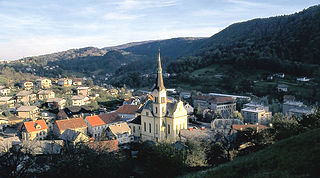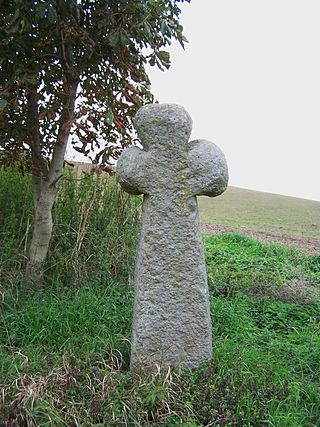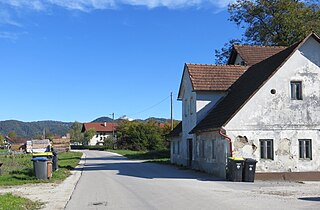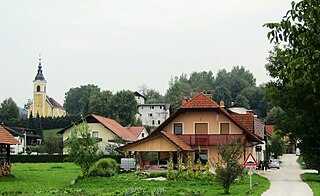A miniature shrine, also referred to in literature as a portable shrine,pocket shrine, or a travel altar, is a small, generally moveable shrine or altar. They vary greatly in size and architectural style, and by which region or culture produced them.

Lithuanian cross crafting is a traditional Lithuanian art of crafting crosses. The making of altars and crosses is an important part of Lithuanian culture. Lithuanian traditional crosses are part of the people's Roman Catholic religion. Approximately since Lithuania became a part of the Russian Empire in the 19th century, these crosses have become a symbol of the Lithuanian people.

Rockeskyll is an Ortsgemeinde – a municipality belonging to a Verbandsgemeinde, a kind of collective municipality – in the Vulkaneifel district in Rhineland-Palatinate, Germany. It belongs to the Verbandsgemeinde of Gerolstein, whose seat is in the like-named town.

The Russian Chapel is a Russian Orthodox chapel located on the Russian Road on the northern side of the Vršič Pass in northwestern Slovenia. The chapel, dedicated to Saint Vladimir, was built by Russian prisoners of war engaged in forced labor in the area during World War I. It serves as both a war memorial and a symbolic link between Slovenia and Russia.

Brezje nad Kamnikom is a settlement in the Municipality of Kamnik in the Upper Carniola region of Slovenia.

Topol pri Medvodah is a small settlement in the Municipality of Medvode in the Upper Carniola region of Slovenia. It lies in the hills northwest of the Slovene capital Ljubljana and is a popular destination for short trips with locals.

Dvor pri Polhovem Gradcu is a village east of Polhov Gradec in the Municipality of Dobrova–Polhov Gradec in the Upper Carniola region of Slovenia.

Šentjošt nad Horjulom is a settlement in the Municipality of Dobrova–Polhov Gradec in the Upper Carniola region of Slovenia. In addition to the main settlement, it also includes the hamlets of Kogel, Krvinet, Kurja Vas, Paradiže, Pišek, Potok, and Stavnik, as well as part of the hamlet of Suhi Dol.

Črni Vrh is a settlement in the hills south of Idrija in the traditional Inner Carniola region of Slovenia. It includes the hamlets of Zgornja Vas, Spodnja Vas, Trate, Trebče, and Zidiše.

Idrijski Log is a dispersed settlement on the right bank of the upper course of the Idrijca River in the hills south of Idrija in the traditional Inner Carniola region of Slovenia. In addition to the settlement of Idrijski Log itself, it also includes the hamlets of Koševnik and Na Pevcu.

Ajbelj is a settlement in the Municipality of Kostel in southern Slovenia. The area is part of the traditional region of Lower Carniola and is now included in the Southeast Slovenia Statistical Region. It is a linear village standing on a hill above Kaptol. To the southeast is a karst polje with sinkholes where there are tilled fields, hay fields, and wooded land. There are large numbers of wild boar, bears, deer, foxes, and badgers in the area.

Dol pri Hrastniku is a settlement in the Municipality of Hrastnik in central Slovenia. The area is part of the traditional region of Styria. It is now included with the rest of the municipality in the Central Sava Statistical Region. In addition to the main settlement, it includes the hamlets of Črdenc, Grča, Javorje, Novi Dol, Pod Bregom, Rakovec, and Slatno.

Conciliation cross, also known as roadside cross or penitence cross, is a stone cross, which was set up in a place where a murder or accident had happened. It occurs mainly in Central Europe.

A summit cross is a Christian cross on the summit of a mountain or hill that marks the top. Often there will be a summit register (Gipfelbuch) at the cross, either in a container or other weatherproof case.

Horjul is a small town in the Inner Carniola region of Slovenia. It is the administrative center of the Municipality of Horjul. It developed from a clustered village on the north side of the marshy valley of Horjulka Creek. It includes the hamlets of Vovčne and Lipalca. Elevations in the territory of the settlement include Brezovec Hill, Rog Hill, and Lupar Hill to the north, and Rožman Peak, Kremenik Hill, and Čelc Hill to the south.

Dobrunje is a formerly independent settlement in the southeast part of the capital Ljubljana in central Slovenia. It belongs to the City Municipality of Ljubljana. It is part of the traditional region of Lower Carniola and is now included with the rest of the municipality in the Central Slovenia Statistical Region. In addition to the main settlement, Dobrunje consists of the hamlets of Devce, Marinki, Na Trdnjavi, Ob Cesti, and Pod Ježo. Rastučnik Creek, which begins below Orle, runs through the western part of the settlement before joining the Ljubljanica.

Bizovik is a formerly independent settlement southeast of the capital Ljubljana in central Slovenia. It belongs to the City Municipality of Ljubljana. It is part of the traditional region of Lower Carniola and is now included with the rest of the municipality in the Central Slovenia Statistical Region. Parts of the settlement include V Dolini along the road toward Orle, Zgornji Konec or Nazaret around the church to the northwest, Pod Kopalom from the church down to the valley, and Na Vasi in the north.

A wayside cross is a cross by a footpath, track or road, at an intersection, along the edge of a field or in a forest. It can be made of wood, stone or metal. Stone crosses may also be conciliation crosses. Often they serve as waymarks for walkers and pilgrims or designate dangerous places.

The basalt cross is a particular type of stone cross found in the Eifel mountains of Germany, bearing witness to the piety of the local population in times past. These crosses indicate their beliefs as well as the wealth and standing of the people who erected them. Details such as accidents, occupations and prayer requests have survived, thanks to the extremely weather-resistant material of which the crosses are made. Their geographic distribution is centred on the basalt quarries of Mayen and Mendig, and covers an area with a radius of approximately 30 kilometres between the Rhine, Ahr and Moselle rivers. The exact number of monuments is not known. Local historian, Kurt Müller-Veltin, estimates that there are about 4,500 wayside crosses and about 6,000 grave crosses. The conservation of these monuments is undertaken by the Rhenisch Society for Monument Conservation.
A shaft cross is a specific type of Latin or High cross, named after its method of construction. The majority of these external monuments consist of the cross or crucifix itself. The cross or crucifix is usually made of stone, occasionally of wood or, more rarely, of metal, and sits above a shaft almost always made of stone, which is fixed to a foundation or base.















































